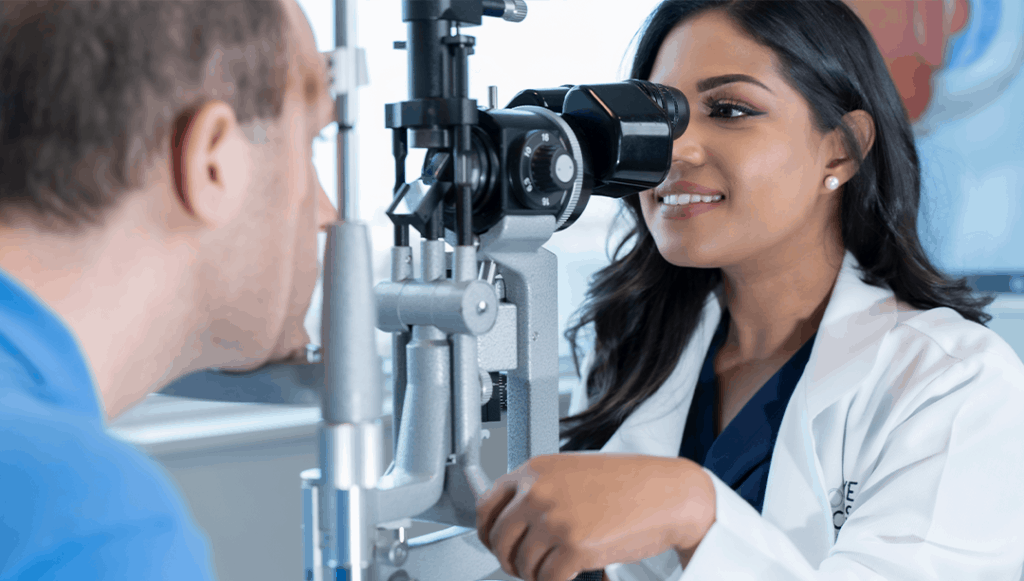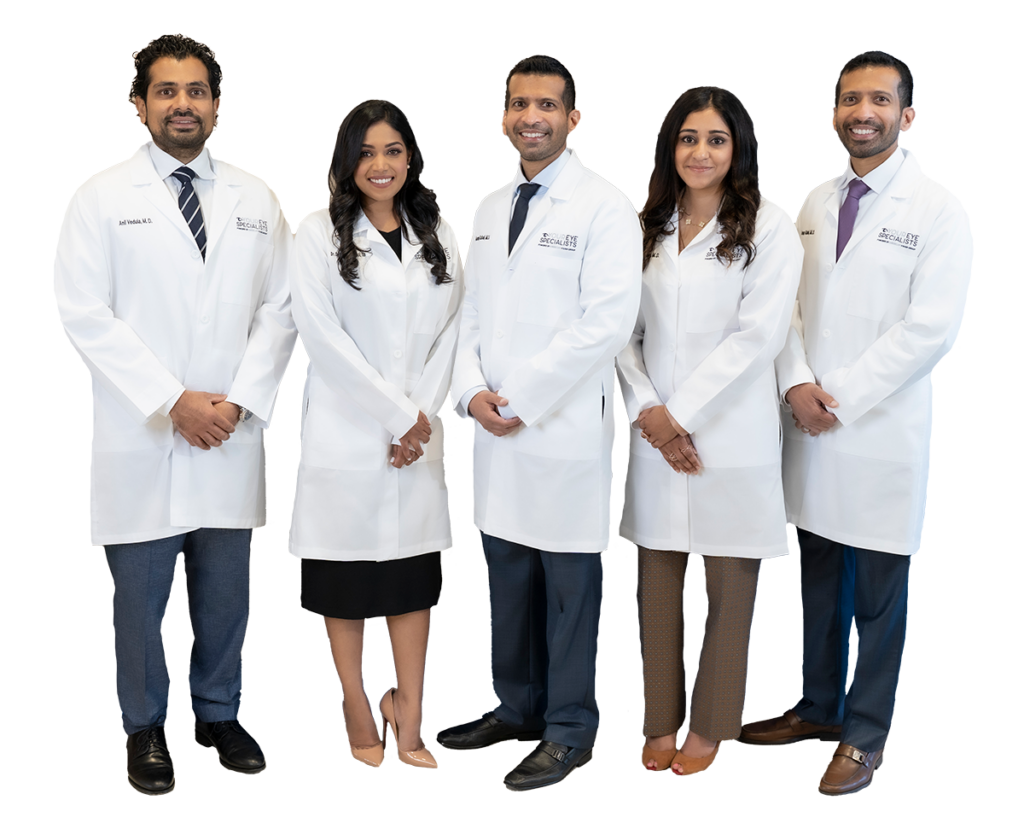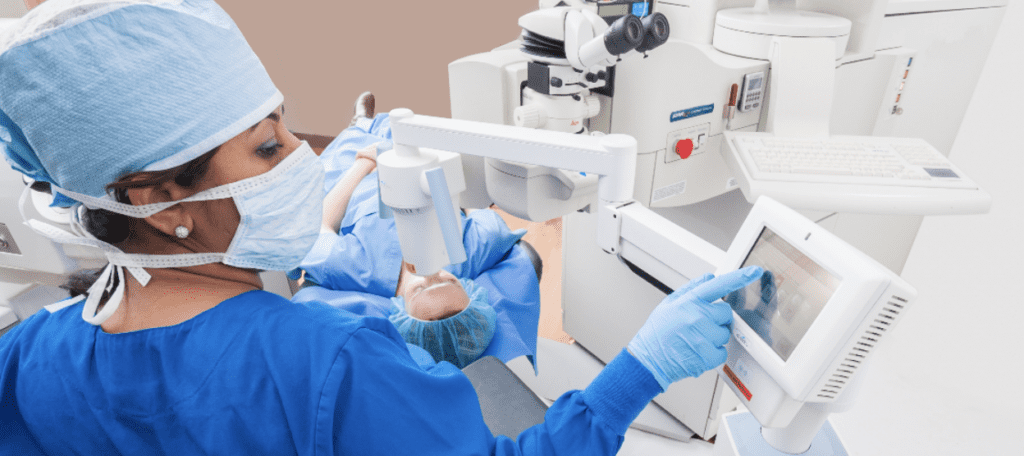Corneal Disease
Keeping the cornea healthy is a vital part of protecting your vision and the health of your eyes. There are many cornea treatments available to assist people suffering from these types of vision issues.
The health of the cornea depends on some factors, including the health of the conjunctiva and the eyelids.

What Is the Cornea and What Is Corneal Disease?
The cornea is the eye’s outermost layer. It is the clear, dome-shaped surface that covers the front of the eye. The main function of the cornea is to allow light to pass through the eye so that it can reach the lens and then the retina. It also helps focus light, like a camera lens. For this reason, the cornea needs to be transparent.
The conjunctiva is the tissue that covers the front part of the eyeball (but not the cornea) and lines the back of the eyelids. Both the conjunctiva and the eyelids contain glands that make tear fluid. Tear fluid is an essential part of the systems, which maintain the health of the cornea. Diseases of the cornea can cause distorted vision or even loss of vision.
If you are worried about your eyes and think you may have a condition on your cornea, don’t hesitate to contact us to schedule a visit with our doctors.
The causes of corneal disease are as varied as the types found in patients. Most cases of corneal disease are due to hereditary causes, infection, trauma, autoimmune disorders, allergy, or secondary causes such as eye diseases.
Risk factors, on the other hand, are common. Some are not modifiable, such as inherited genetic conditions, while others can be avoided by limiting exposure to infection and taking precautionary steps.
Common symptoms of corneal disease include:
- Visual impairment, including blurred or clouded vision
- Severe pain in the affected eye
- Tearing
- Sensitivity to light
Some patients may experience additional symptoms such as a headache, nausea, or fatigue
Of course, many of these symptoms are prominent in other eye conditions. For example, blurred vision could be the result of an irregular tear layer, scarring, cataracts, or swelling. Pain and light sensitivity, especially, may be severe if conditions affect the epithelium. Speak with your doctor promptly to seek treatment options!
There are a variety of corneal diseases, albeit all under the same umbrella term. Some of the most common types of corneal disease include:
- Infections. Bacterial, fungal, or viral keratitis, plus parasitic diseases
- Trauma. Abrasions or extended exposure to toxic chemicals
- Dystrophies. Fuchs dystrophy, map-dot-fingerprint dystrophy, or lattice corneal dystrophy
- Autoimmune Disorders. Wegener’s disease, rheumatoid arthritis, and lupus
- Nutritional Deficiencies. Vitamin A deficiency
Furthermore, the cornea may be damaged by common eye conditions, including tear film abnormalities, glaucoma or eyelid disorders.
As you can see, the types of corneal disease are quite varied. Your eye care specialist will help determine which was the cause of your corneal disease and how best to treat the issue promptly and with precision.
Below is a list of common corneal diseases, including pterygium, corneal edema, keratoconus and how treatment for them can look.
Pterygium
A pterygium is a benign growth of conjunctiva that can ultimately cause irritation and lead to poor vision. A pterygium can be removed surgically if it causes discomfort or distorts vision (by inducing astigmatism). It can also be removed for cosmetic purposes.
The procedure is performed under local anesthesia and involves peeling the growth away from the cornea and trimming it from the conjunctiva, the white of the eye. If this is all that is done, the pterygium has a high likelihood of growing back, and the recurrence can often be more aggressive than the original pterygium. Our surgeons use state-of-the-art techniques, including the use of conjunctival grafts, amniotic membranes, and anti-scarring medications, to prevent recurrences. We also make use of innovative tissue sealants to prevent suture related discomfort and scarring.
Corneal Edema or Fuchs Dystrophy
Fuchs dystrophy is an inherited condition in which the cells lining the inside of the cornea are diseased and fewer in number. These cells are called endothelial cells, and they are responsible for keeping the cornea thin and clear and preventing it from swelling. Fuchs dystrophy is inherited in an autosomal dominant fashion, which means that there is a 50% chance of each child of an affected individual having the condition.
At birth, each person is born with a set number of endothelial cells. With aging, there is a typical loss of cells; however, in Fuchs dystrophy, this loss of cells is accelerated so that by age 50 or 60 (earlier or later in some patients), affected patients may start to experience symptoms from corneal swelling. Symptoms include blurred vision and fluctuating vision, with vision usually worse in the morning and improving during the day.
In mild cases, before there has been extensive cell loss, eye drops can be used to help reduce swelling and clear the vision. In more advanced cases, however, there may be too much swelling and clouding of the cornea for medicines to overcome. For these patients, a corneal transplant may be recommended. Up until a few years ago, the only surgical option involved a full-thickness corneal transplant, in which all five layers of the cornea were removed and replaced. A new procedure, called DSAEK (Descemet’s stripping automated endothelial keratoplasty), has been a medical breakthrough. In this procedure, only the inner, diseased layers of the cornea, including the endothelial cells are replaced. This method, compared to a traditional corneal transplant, is much safer and allows for a much quicker recovery. Within a matter of a few weeks to months, the new transplanted endothelial cells pump out the swelling in the cornea, restoring a patient’s corneal clarity and significantly improving the vision.
Keratoconus
Keratoconus, which means “cone-shaped cornea,” is a progressive disorder resulting in thinning and bulging of the cornea. It is an unusual eye condition, affecting one in 2000 individuals.
People who develop keratoconus are usually in their twenties. Early in the course of the disease, patients may notice mild blurring or distortion of their vision. Patients usually also have a high degree of astigmatism and frequent changes in their glasses prescription. Sometimes, patients with keratoconus can achieve good vision in glasses. However, most of the time patients will need to wear a rigid contact lens for best vision. A small percentage of patients cannot achieve good vision with either glasses or contact lenses. For these patients, surgery may be necessary.
Having trained with the nation’s leading corneal surgeons, Drs. Kubal and Vedula offer advanced keratoconus treatments not offered elsewhere, including Intacs and partial thickness corneal transplants (also known as DALK or deep anterior lamellar keratoplasty).
Other Common Cornea Problems
Because the cornea is the outermost layer of the eye, it can become injured due to causes that have nothing to do with a corneal disease. Some examples of this include:
- Scratches from an unknown source. Luckily, our corneas typically heal themselves after any minor scratches or injuries, but if you experience effects such as eye pain, light sensitivity, inflammation, redness in the eye, and blurry vision, it could be that you have a deep scratch on your cornea that may need further treatment.
- Inflammation from contact lenses. If you wear your contact lenses beyond the recommended period of time, they can start to cause abrasions on your cornea.
- Seasonal allergy symptoms. Pollen in the air is not good news for our corneas! Post-allergic symptoms may include redness, swelling, itching and stinging.
When it comes to corneal diseases, there are a variety of treatment options available that target the specific symptoms affecting your cornea.
If your cornea is dry:
There are a few different ways to effectively treat your dry corneas. To keep your eyes healthy, try following one of these recommended treatments:
- Increasing tear production. You may be prescribed specialized eye drops that increase your tear production.
- Adding or conserving tears. Some doctors will either add artificial tears or block your tear ducts in order to preserve natural tears; these are both common and successful treatment options for dry corneas.
- Treating the contributing eyelid. There are some prescription eye drops that will help decrease inflammation around your eye.
For most patients, successful treatment of a cloudy cornea means some type of surgery. Corneal laser eye surgery and corneal transplants are two common surgeries for cloudy corneas. In some cases, medication may suffice. In addition to this, optical therapy can be incredibly helpful when it comes to regaining your vision.
It’s important to see an ophthalmologist or other health care provider if you are experiencing a cloudy cornea, in order to prevent further damage.
If your cornea has an abrasion:
The good news is that most corneal abrasions do heal over time. If you’re looking to speed up the process, however, here are some effective treatment options:
- Patching the eye
- Antibiotics
- Eye drops such as Voltaren or Acular, along with disposable soft contact lens
The best options for your corneal abrasion treatment will depend on the severity of your abrasion, the location of your injury, and the specific kind of pain you’re experiencing.
A corneal transplant may be recommended when certain infections, injuries, or diseases leave scars or distort the shape of the cornea so much that good vision is not possible with glasses or contact lenses.
During a corneal transplant, a round, central portion of the cornea is removed with special microsurgical instruments and replaced with a healthy donor cornea. The donor cornea is provided from the eye bank, which harvests the tissue from a healthy human donor and screens the tissue to ensure that it is free of disease and of high quality to be used for transplantation. The donor cornea is carefully sutured into place with the help of an operating microscope using many tiny stitches that cannot be seen with the naked eye. A penetrating keratoplasty (DALK) is a variant in which the endothelium – the inner lining of the cornea – is preserved if it is healthy. Both surgeries take about an hour and are performed on an outpatient basis.
The eye is numbed with local anesthesia, and patients do not feel any discomfort during the surgery. A patch is placed over the eye after surgery, and patients can go home the very same day.
Recovery time with corneal transplant varies between patients and specific procedures. The risk of rejection is relatively small, as the cornea is “immunologically privileged,” meaning that no matching of donor to recipient is required. Steroid eye drops will be prescribed to protect against rejection. Rejection happens in less than 20% of cases overall.
DSAEK
DSAEK (Descemet’s stripping automated endothelial keratoplasty) is a revolutionary new procedure that has been replacing full-thickness corneal transplants as the procedure of choice for Fuchs dystrophy and other conditions resulting in corneal swelling. In DSAEK, only the inner part of the cornea consisting of the diseased endothelial cells is removed and replaced.
This procedure is accomplished through a small incision no bigger than the size of the incision used in cataract surgery. Compared with a full thickness transplant, DSAEK allows for a significantly faster recovery, eliminating swelling and restoring vision in a matter of weeks. Both of our doctors are fellowship-trained corneal surgeons specializing in DSAEK surgery. For more information, contact our office.
Instances
Instances are semicircular plastic ring segments that can be surgically placed in the cornea to flatten and reshape the cornea. Although they were initially developed for the treatment of low levels of nearsightedness, they are particularly useful for patients with keratoconus. Before the development of Instances, patients with keratoconus who could no longer be corrected with contact lenses or who were intolerant of contact lenses required a corneal transplant for best vision. In select patients, Instances may prevent the need for a corneal transplant.
Is Cross-Linking Right for Me?
If you are suffering from progressive keratoconus, corneal cross-linking may be right for you.
What People Are Saying About Us
Trust Your Vision to South Florida’s Premier Eye Doctors
Saying YES is all it takes!


